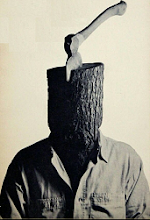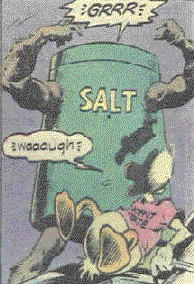Holy Crap, I Never Thought of That: Eisner’s Legacy
Damn near every comic blog is writing about Will Eisner right now. His death at age eighty-seven has inspired retrospectives about the man and his work. At the risk of being redundant, I’d like to say something as well.
When I first fell into comics as a young'un, I plunged in with the intensity and focus common to boys around the age of twelve. I borrowed comics from friends, raided libraries for books about comics, and researched the field as much as I could.
One book I found at the library was the Smithsonian Book of Comic Book Comics. It contained samples from many of the early greats: Sheldon Meyer, Siegel and Schuster, and, yep, Will Eisner. The Smithsonian volume gave me my first look at The Spirit, the work most associated with Eisner.
First I was confused by the glowing praise heaped upon the stories. The art resembled Mad Magazine more than a comic about a masked detective, more Jack Davis than Bob Kane. It didn't seem right at all. Plus, the stories were oddball, too. They blended action and humor in ways that feel perfectly natural for comics, despite the fact that almost nobody else seems to be able to reach that same pitch-perfect mixture.
I couldn’t put my finger on why they were good. But I knew they were.
I reread them a few times and tried to figure it out. One of Eisner’s famous conceits was the ever-changing logo for the Spirit stories. In one story, the words “The Spirit” were spelled out by letters made up of individual pieces of paper floating down a gutter towards the reader, with a sewer grate in the foreground. Another story had the logo painted on the side of a building. My young self thought that was the coolest idea in comics.
As time went by and I saw more of his work, I was bowled over by the level of innovation he put into the art. More than anything, what made his work important was that Eisner took chances. Rather than accept the format of the art as it was given to him, he pushed it to new limits. He was the great experimenter of the medium.
A few years back I bought his seminal “first graphic novel,” A Contract with God. (I use the quotes to prevent arguments—Contract is the “first” graphic novel in the way that Columbus “discovered” America. Others did it first, yes, but Contract was the first one that stuck.)
If I may be a heretic, I must admit: Contract isn’t all that well-written. The first of its stories is moving, but the others didn’t add up to much. Eisner’s more realistic works never did much for me as stories. However, his ability to tell his stories graphically was phenomenal. Breaking free from the confines of the panel, using the lettering of the text as art itself, bleeding images one into the other...amazing.
Will Eisner had the ability to create developments in comic art that seem astonishing at the time and blazingly obvious in retrospect. He recognized what was right in front of everybody but nobody could see.
That there, that’s the signature quality of genius.
He was the best there ever was.
When I first fell into comics as a young'un, I plunged in with the intensity and focus common to boys around the age of twelve. I borrowed comics from friends, raided libraries for books about comics, and researched the field as much as I could.
One book I found at the library was the Smithsonian Book of Comic Book Comics. It contained samples from many of the early greats: Sheldon Meyer, Siegel and Schuster, and, yep, Will Eisner. The Smithsonian volume gave me my first look at The Spirit, the work most associated with Eisner.
First I was confused by the glowing praise heaped upon the stories. The art resembled Mad Magazine more than a comic about a masked detective, more Jack Davis than Bob Kane. It didn't seem right at all. Plus, the stories were oddball, too. They blended action and humor in ways that feel perfectly natural for comics, despite the fact that almost nobody else seems to be able to reach that same pitch-perfect mixture.
I couldn’t put my finger on why they were good. But I knew they were.
I reread them a few times and tried to figure it out. One of Eisner’s famous conceits was the ever-changing logo for the Spirit stories. In one story, the words “The Spirit” were spelled out by letters made up of individual pieces of paper floating down a gutter towards the reader, with a sewer grate in the foreground. Another story had the logo painted on the side of a building. My young self thought that was the coolest idea in comics.
As time went by and I saw more of his work, I was bowled over by the level of innovation he put into the art. More than anything, what made his work important was that Eisner took chances. Rather than accept the format of the art as it was given to him, he pushed it to new limits. He was the great experimenter of the medium.
A few years back I bought his seminal “first graphic novel,” A Contract with God. (I use the quotes to prevent arguments—Contract is the “first” graphic novel in the way that Columbus “discovered” America. Others did it first, yes, but Contract was the first one that stuck.)
If I may be a heretic, I must admit: Contract isn’t all that well-written. The first of its stories is moving, but the others didn’t add up to much. Eisner’s more realistic works never did much for me as stories. However, his ability to tell his stories graphically was phenomenal. Breaking free from the confines of the panel, using the lettering of the text as art itself, bleeding images one into the other...amazing.
Will Eisner had the ability to create developments in comic art that seem astonishing at the time and blazingly obvious in retrospect. He recognized what was right in front of everybody but nobody could see.
That there, that’s the signature quality of genius.
He was the best there ever was.





0 Comments:
Post a Comment
<< Home